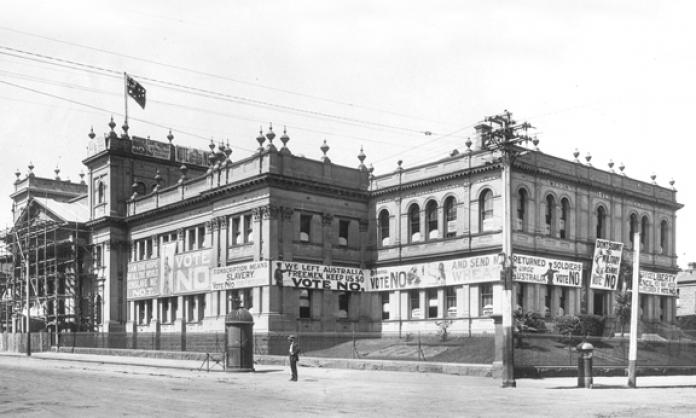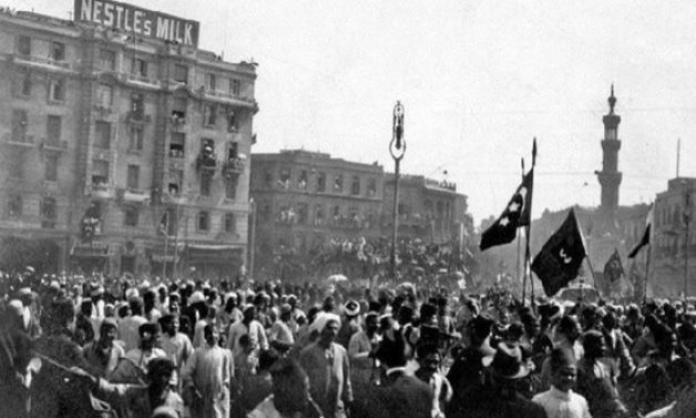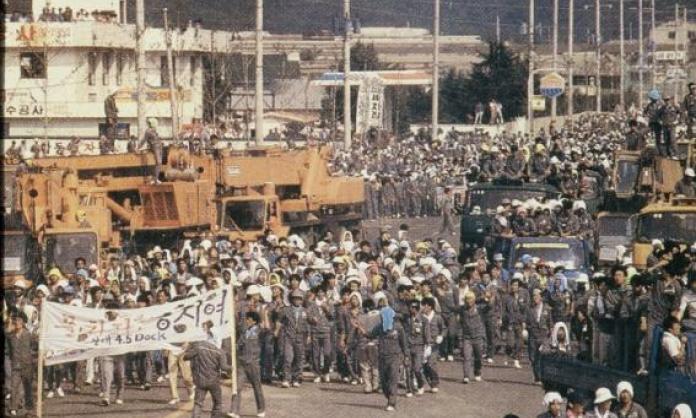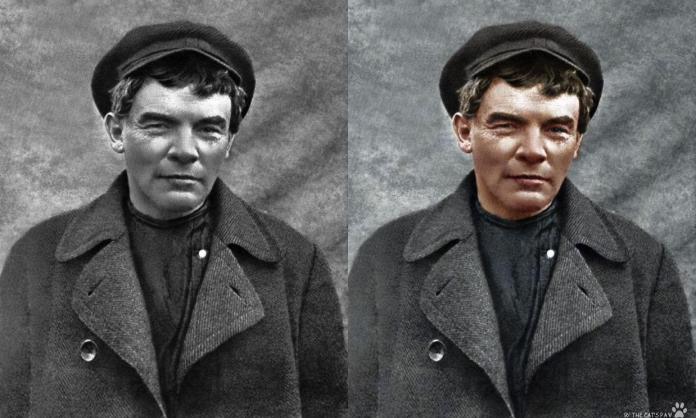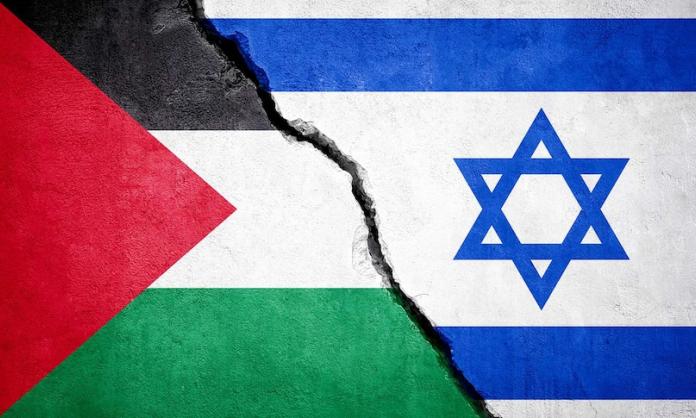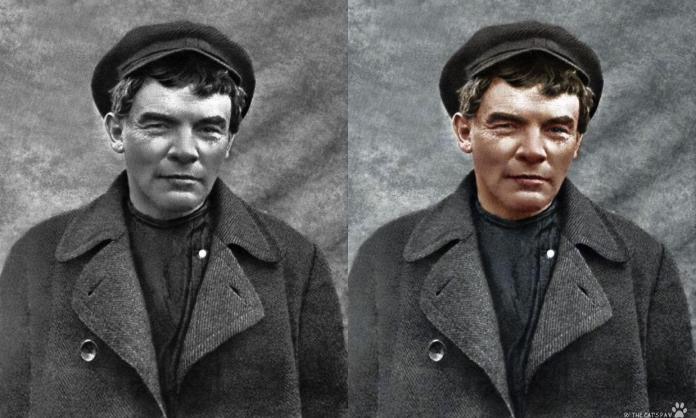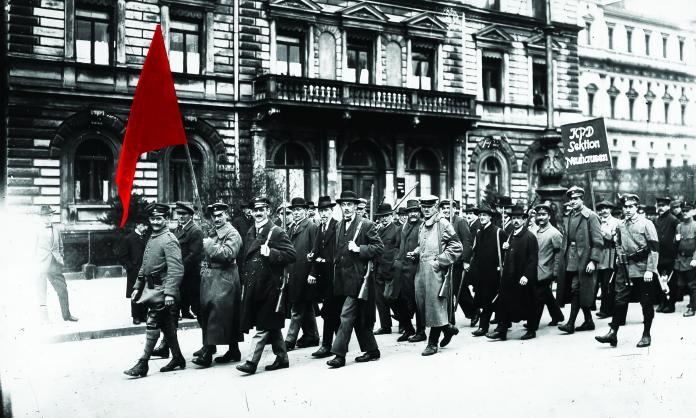The twenty-eighth of October is the centenary of one of the greatest triumphs of the Australian working class movement: the defeat of the World War One conscription referendum.
This was an incredibly bitter and hard-fought battle against the combined weight of every section of the rich and powerful and their middle class supporters. The whole of the mainstream press waged an absolutely hysterical campaign against the opponents of conscription, and for the slaughterhouse that was the Western front.
The “antis” were denounced as traitors, German agents, left wing “saboteurs”, “disloyal Irish dogs” and cowards who had abandoned their mates at the front. They suffered severe state repression under the War Precautions Act.
Harsh censorship measures banned most material opposing conscription and anything critical of the murderous imperialist war or that “prejudiced recruiting”. In one typical incident, military authorities raided Trades Hall, Melbourne’s union headquarters, on 29 July 1916 and seized anti-conscription pamphlets and then went on to raid the office of the Labour Call newspaper.
Numerous socialist opponents of the war were jailed or deported. The revolutionary Industrial Workers of the World, which Labor prime minister Billy Hughes blamed for the defeat of the referendum, was outlawed and well over a hundred of its members jailed. Thousands of people of German descent were interned in concentration camps.
Violent mobs of armed soldiers were unleashed on the streets to break up anti-conscription meetings and smash left wing offices and meeting halls. Opponents of the war were repeatedly physically assaulted and shot at. Meanwhile, employers enforced a ruthless policy of sacking thousands of young men in order to force them to “volunteer” for the army.
This was backed up by a virulent campaign of anti-German and anti-Irish racism that makes today’s racist reactionaries like Andrew Bolt, Pauline Hanson and Corey Bernardi seem mild mannered.
Workers had to campaign not just against the conservatives, but against Hughes and NSW Labor premier William Holman and most of their cabinets.
The core sections of the blue collar working class drove the anti-conscription campaign. It is important to emphasise this point, because conventional accounts of the war very much play down the intense class struggle that tore Australia apart during these years and the scale of working class radicalisation and opposition to the war.
All the rage
Initially, World War One was genuinely popular at its outset in a way that no war since has been. British Empire patriotism surged. The middle class identified strongly with Britain and was absolutely euphoric about the war.
Melbourne University academics purged German-born staff, victimised students who opposed the war and voted to give up drink for the war effort. Middle class football teams pulled out of playing. Pubs were forced to close early. Rampaging mobs attacked German and other “foreign”-owned shops.
Pro-war jingoism also impacted workers, though the mood among the class was more subdued than in middle class circles. Workers were disoriented by the fact that the ALP leadership stridently backed the war. Andrew Fisher, soon to be elected prime minister, notoriously declared that Australia would defend the British Empire “to our last man and our last shilling”.
With the outbreak of war, some strikes were called off. Germans were hounded out of some jobs by fellow workers, and sizeable numbers of union members enlisted during the first 18 months. Some workers enlisted because of rising unemployment, others out of a sense of adventure – an escape from the monotony of factory work. Some naively thought the war would be over by Christmas. Nonetheless, there was undoubtedly some element of British patriotic sentiment.
Yet within two years there was a sea change in mass sentiment. Against all the odds, a majority voted against conscription. Moreover, while the official leaders of the anti-conscription campaign emphasised that they were patriots who supported voluntary enlistment, the vote reflected a growing anti-war sentiment and a heightened class consciousness amongst large numbers of workers.
This insurgent radicalism eventually exploded in the long 1917 general strike and the defeat of a second conscription referendum by an even larger margin. The upheaval tore the ALP apart. Hughes and his supporters were expelled. So was Holman, along with numerous other state Labor politicians.
A dramatic shift in popular consciousness
A combination of factors fuelled working class radicalisation. It quickly became apparent that the sacrifices for the war effort were not being evenly shared. Workers were being told to fight and die for the glory of king and country, but the capitalists were making virtually no sacrifices at all. War profiteering was rampant, shipping companies were making record profits, and the rich were paid handsome rates of interest on war bonds.
A sharp rise in unemployment at the start of the war caused severe hardship in an era in which there was little social welfare. Wages were held down while prices rose relentlessly. Harsh legal restrictions were imposed on workers’ rights, and the War Precautions Act undermined civil liberties and free speech.
By the end of 1915, economic privation and the immense casualties on the Western front had eroded enthusiasm for the war. In Melbourne, waterside workers banned the export of wheat, in protest at sharply rising bread prices.
In the last months of 1915 and the first few months of 1916, there was a marked rise in strike action – often in defiance of union officials. Workers’ bargaining position had improved as unemployment fell and a number of localised strikes scored victories and built the confidence to fight back.
A turning point was a victory by Broken Hill miners. The Broken Hill mines were one of the country’s largest employers, a centre of left wing militancy and vital to the war effort, producing lead for bullets.
Underground miners formed a rank and file committee to lead an all-out fight for a 44-hour week, initially in defiance of their left wing syndicalist union leaders. In the face of a barrage of attacks calling them traitors and German agents sabotaging the war effort, they held their ground and scored a decisive victory.
This industrial victory gave the miners the confidence to play a leading role in the broader political fight. Broken Hill became a bastion of opposition to the war and voted overwhelmingly against conscription.
Revolutionary socialists such as Percy Brookfield, who had established their credibility as leaders of the rank and file strike committee, formed the Labor Volunteer Army. Thousands of young men vowed never to submit to conscription. The Labor Volunteer Army was vital in defending anti-conscription meetings from right wing attacks, and its example spread to other cities.
Hughes pushes for a vote
After spending most of the first half of 1916 in England propagandising for the war, Billy Hughes arrived back in Australia at the end of July determined to ride roughshod over the growing working class opposition to conscription. He was urged on by the full chorus of ruling class opinion.
Hughes opted for a referendum because he didn’t think he could get legislation for conscription through the Senate, in which Labor had an overwhelming majority. Hughes and his supporters in the Labor cabinet were supremely confident that, with the backing of the press and middle class patriotic opinion, they would decisively win the referendum.
An overwhelming vote for conscription would be used to bludgeon the rest of the Labor MPs into line and intimidate and isolate the unions and the left outside parliament. Hughes would have a mandate. Or so he thought. Hughes and the whole of the establishment had badly miscalculated. The intense working class revolt was stiffening the resolve of the union leadership.
Union officials were much more subject to pressure from rank and file workers than the Labor ministers who backed the prime minister. The union leaders were frustrated that the government that they had loyally supported had delivered nothing. A sore point was Hughes reneging on a promise of a referendum to control prices.
Some union officials were genuinely shifting to the left in response to the crisis. Others feared being thrown out of office by a radicalised membership if they did not make a stand against conscription. Still others worried that if Labor did not shift significantly to the left, it would be outflanked by more radical forces and a mass revolutionary party would be formed.
For a combination of all these reasons the union leaders, including quite conservative ones such as the heads of the Australian Workers Union, turned decisively against Hughes and intervened in the ALP to isolate the pro-conscription forces. NSW premier Holman lamented that the Victorian party was “in a most unfortunate position, having apparently succumbed almost unanimously to the pressure brought to bear by the workers”. Truly shameful!
Up the Irish!
The 1916 Easter Rebellion in Ireland was the final nail in the coffin for Hughes. More than 20 percent of the Australian population (and an even higher percentage of the working class) was then of Irish descent.
It was not simply that there was widespread sympathy among Irish Australian workers for the Dublin rebels who had been executed for rising up against centuries of British oppression. In the aftermath of the Easter rising, Irish Australians, much like Muslims today, were persecuted as a treacherous fifth column that had stabbed England in the back in its hour of need.
Class and national grievances reinforced each other. Young Irish Australian women and men from the inner city working class suburbs of Melbourne, Sydney and Brisbane became a key driving force in the militant protests that confronted the conscriptionists.
Initially pro-conscription forces controlled the streets, and anti-conscription meetings and rallies were broken up by police or marauding soldiers. But the working class anti-conscription forces became more organised to defend their rallies.
A 60,000-100,000 strong rally in August 1916 in the Sydney Domain (Sydney’s population was then only about 760,000) fought off violent right wing attacks. This was a turning point. From then on, the pro-conscription forces were under siege. Pro-conscription meetings in working class suburbs were turned into bedlam by thousands of young protesters. The protests and mass rallies in turn were backed by strike action in a number of cities.
The story of Les Darcy – widely considered Australia’s greatest ever boxer – starkly reveals the depth of the social polarisation. A working class boy from Maitland, Darcy, who left school at the age of 12 to support his large Irish Catholic family, became a folk hero to rival Ned Kelly. By the time he was 20, this apprentice blacksmith was the welterweight, middleweight and heavyweight champion of Australia.
At the time, boxing was the premier working class sport, and Darcy was incredibly popular. Special trains were put on to carry his fans from Newcastle to see him fight at Sydney’s Rushcutters Bay stadium.
It is unclear how political Darcy was, but his mother would not let him enlist in the army, and he refused to have his name used on recruitment posters, saying he would not be responsible for leading other men to their deaths.
For this he was subject to relentless attacks as a coward and a shirker – a fit young man who refused to enlist. Then, on the eve of the conscription referendum and in defiance of the War Precautions Act, Darcy, having been denied a passport, stowed away on a ship to the US to fight for the world boxing title.
The vitriolic campaign against him only intensified. One article, headed “The flappers ideal and the schoolboys hero”, declared: “Les Darcy has evaded the military authorities, set aside his kinship with the gallant men of Gallipoli, scorned his obligations to his king, his flag and his country”. Under pressure from the Australian government, US authorities barred him from fighting. He subsequently fell ill and died in May 1917, aged only 21.
There was an enormous reaction to Darcy’s death among workers. He was hailed as a martyr and hero, driven to a lonely death by vindictive authorities out to persecute anyone who would not submit.
After an immense funeral procession through the streets of San Francisco, Darcy’s embalmed body was returned to Sydney, where up to half a million people filed past his open casket to show their respects. His hero status lingered on for decades afterwards in working class communities.
Conscription defeated
Despite a concerted last minute attempt by Hughes and the military authorities to rig the ballot, the No campaign narrowly triumphed, by 52 percent to 48 percent, on 28 October 1916. South Australia, NSW and Queensland all voted No.
The victory gave the more left wing elements in the ALP the confidence to override the moderates, who were hoping to patch things up with Hughes to hold the party together. On 4 December, a special ALP conference in Melbourne voted to expel Hughes and all Labor MPs who supported conscription.
The anti-conscription victory inflamed working class industrial militancy. Almost immediately after the referendum result was announced, coal miners launched an all-out strike that won a decisive victory.
In 1917, there was a tremendous upsurge, culminating in a mass strike that lasted for months. Starting in Sydney’s Randwick tramway workshops, it spiralled under insurgent rank and file pressure, first across NSW and then across the country.
But it was not just the working class that was mobilising. Society was polarising sharply along class lines.
The ruling class was not about to let a mere detail like a democratic vote stand in the way of a war that was so vital to its imperialist interests and profits. The rich conspired to force a second referendum, which, despite even more blatant vote rigging (tens of thousands of people of German descent were denied a vote), resulted in an even more decisive victory for No.
Shocked by these defeats, the ruling class began to mobilise to teach the recalcitrant working class not to step out of line. Ruling class fears were further heightened by the victory of the Russian Revolution.
Secret armies of “worthy citizens” were formed. Plans were drawn up for aerial bombing of mass protests, and for blowing up the bridges across Melbourne’s Yarra River to prevent the Bolshevik hordes from the working class suburbs disturbing the restful sleep of the good bourgeois citizens of Toorak.
The twenty-eighth of October 1916 was an amazing victory that should be commemorated as an inspiring example for everyone opposed to the horrors inflicted by imperialist war.




